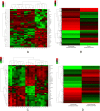Intestinal mucosa-derived DNA methylation signatures in the penetrating intestinal mucosal lesions of Crohn's disease
- PMID: 33963246
- PMCID: PMC8105344
- DOI: 10.1038/s41598-021-89087-6
Intestinal mucosa-derived DNA methylation signatures in the penetrating intestinal mucosal lesions of Crohn's disease
Abstract
The purpose of this study was to evaluate genome-wide DNA methylation changes in intestinal mucosa tissue of adult patients with Crohn's disease comprehensively. DNA methylation chip was used to analyze abnormal methylation sites among penetrating and non-penetrating intestinal mucosa tissue of Crohn's disease and normal intestinal mucosa tissue of healthy controls. Methylation abnormalities of different locus were verified by pyrosequencing and quantitative polymerase chain reaction. Differential DNA methylation sites were participated in the positive regulation of apoptosis and the positive regulation of IL-8 production and were enriched in signaling pathways related to inflammatory bowel disease and extracellular matrix receptor interaction signaling pathways. Correlation analysis showed that the methylation abnormalities of HLA-DRB1 (r = - 0.62, P < 0.001), MUC1 (r = - 0.45, P = 0.01), YPEL5 (r = - 0.55, P = 0.001) and CBLB (r = - 0.62, P < 0.001) were significantly negatively correlated with their relative expression levels. The degree of methylation abnormality of MUC1 was negatively correlated with the disease activity score of Crohn's disease (r = - 0.50, P = 0.01). Apoptosis, interleukin-8 production and abnormal extracellular matrix might be involved in the mechanism of penetrating intestinal mucosal lesions in Crohn's disease. The degree of abnormal methylation of MUC1 was negatively correlated with the disease activity of Crohn's disease.
Conflict of interest statement
The authors declare no competing interests.
Figures






Similar articles
-
Blood-Derived DNA Methylation Signatures of Crohn's Disease and Severity of Intestinal Inflammation.Gastroenterology. 2019 Jun;156(8):2254-2265.e3. doi: 10.1053/j.gastro.2019.01.270. Epub 2019 Feb 16. Gastroenterology. 2019. PMID: 30779925 Free PMC article.
-
Abnormalities in mucin gene expression in Crohn's disease.Inflamm Bowel Dis. 1999 Feb;5(1):24-32. doi: 10.1097/00054725-199902000-00004. Inflamm Bowel Dis. 1999. PMID: 10028446 Clinical Trial.
-
Patient-derived organoid biobank identifies epigenetic dysregulation of intestinal epithelial MHC-I as a novel mechanism in severe Crohn's Disease.Gut. 2024 Aug 8;73(9):1464-1477. doi: 10.1136/gutjnl-2024-332043. Gut. 2024. PMID: 38857990 Free PMC article.
-
Myosin light chain kinase regulates intestinal permeability of mucosal homeostasis in Crohn's disease.Expert Rev Clin Immunol. 2020 Dec;16(12):1127-1141. doi: 10.1080/1744666X.2021.1850269. Epub 2020 Dec 29. Expert Rev Clin Immunol. 2020. PMID: 33183108 Review.
-
Visceral adiposity and inflammatory bowel disease.Int J Colorectal Dis. 2021 Nov;36(11):2305-2319. doi: 10.1007/s00384-021-03968-w. Epub 2021 Jun 9. Int J Colorectal Dis. 2021. PMID: 34104989 Review.
Cited by
-
Genome-Wide DNA Methylation Profile in Whole Blood of Patients With Chronic Spontaneous Urticaria.Front Immunol. 2021 Sep 3;12:681714. doi: 10.3389/fimmu.2021.681714. eCollection 2021. Front Immunol. 2021. PMID: 34539625 Free PMC article.
-
Dynamic proximity interaction profiling suggests that YPEL2 is involved in cellular stress surveillance.Protein Sci. 2024 Feb;33(2):e4859. doi: 10.1002/pro.4859. Protein Sci. 2024. PMID: 38145972 Free PMC article.
-
The Role of Genetic and Epigenetic Regulation in Intestinal Fibrosis in Inflammatory Bowel Disease: A Descending Process or a Programmed Consequence?Genes (Basel). 2023 May 27;14(6):1167. doi: 10.3390/genes14061167. Genes (Basel). 2023. PMID: 37372347 Free PMC article. Review.
-
Increased CpG methylation at the CDH1 locus in inflamed ileal mucosa of patients with Crohn disease.Clin Epigenetics. 2024 Feb 14;16(1):28. doi: 10.1186/s13148-024-01631-z. Clin Epigenetics. 2024. PMID: 38355645 Free PMC article.
-
Mucosal DNA methylome alteration in Crohn's disease: surgical and non-surgical groups.Front Genet. 2023 Nov 17;14:1244513. doi: 10.3389/fgene.2023.1244513. eCollection 2023. Front Genet. 2023. PMID: 38046046 Free PMC article.
References
-
- Van Assche G, et al. The second European evidence-based Consensus on the diagnosis and management of Crohn's disease: Definitions and diagnosis. J. Crohns Colitis. 2010;4:7–27. - PubMed
-
- de Barros KSC, Flores C, Harlacher L, Francesconi CFM. Evolution of clinical behavior in Crohn's disease: Factors associated with complicated disease and surgery. Dig. Dis. Sci. 2017;62:2481–2488. - PubMed
-
- Fogel O, Richard-Miceli C, Tost J. Epigenetic changes in chronic inflammatory diseases. Adv. Protein Chem. Struct. Biol. 2017;106:139–189. - PubMed
Publication types
MeSH terms
Substances
LinkOut - more resources
Full Text Sources
Other Literature Sources
Medical
Research Materials
Miscellaneous

